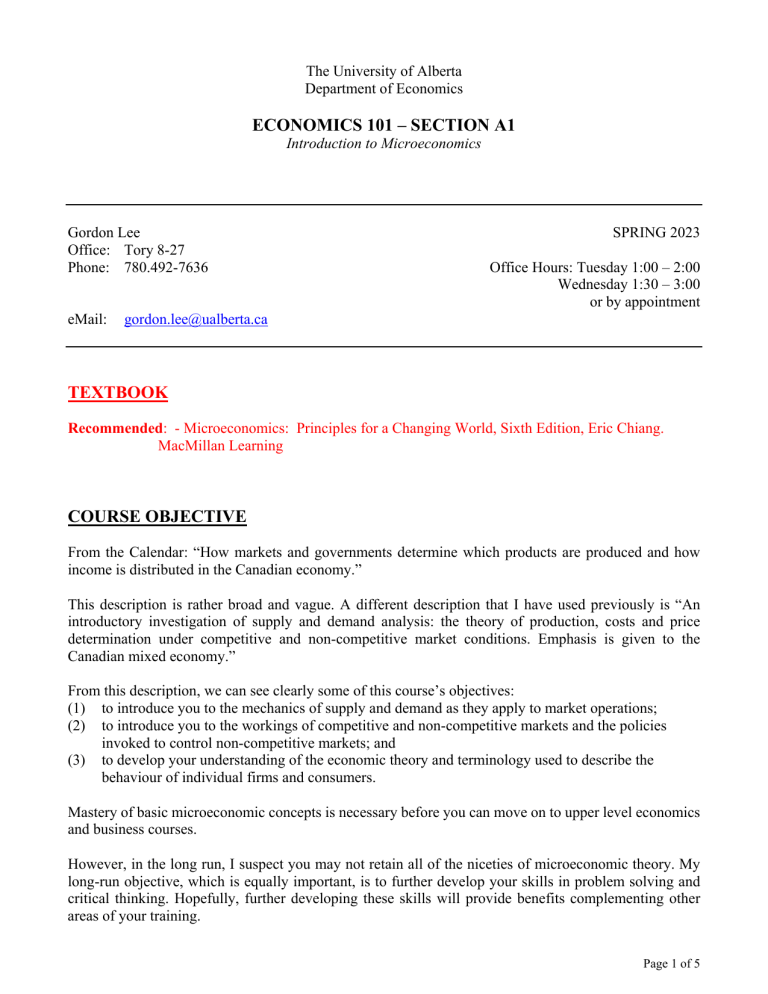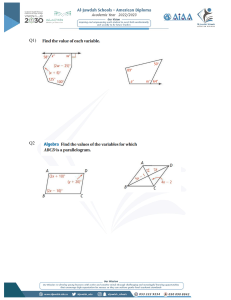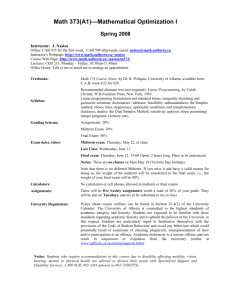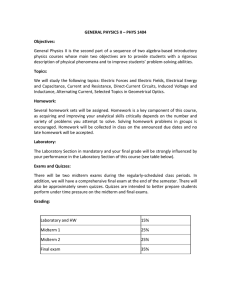
The University of Alberta
Department of Economics
ECONOMICS 101 – SECTION A1
Introduction to Microeconomics
Gordon Lee
Office: Tory 8-27
Phone: 780.492-7636
eMail:
SPRING 2023
Office Hours: Tuesday 1:00 – 2:00
Wednesday 1:30 – 3:00
or by appointment
gordon.lee@ualberta.ca
TEXTBOOK
Recommended: - Microeconomics: Principles for a Changing World, Sixth Edition, Eric Chiang.
MacMillan Learning
COURSE OBJECTIVE
From the Calendar: “How markets and governments determine which products are produced and how
income is distributed in the Canadian economy.”
This description is rather broad and vague. A different description that I have used previously is “An
introductory investigation of supply and demand analysis: the theory of production, costs and price
determination under competitive and non-competitive market conditions. Emphasis is given to the
Canadian mixed economy.”
From this description, we can see clearly some of this course’s objectives:
(1) to introduce you to the mechanics of supply and demand as they apply to market operations;
(2) to introduce you to the workings of competitive and non-competitive markets and the policies
invoked to control non-competitive markets; and
(3) to develop your understanding of the economic theory and terminology used to describe the
behaviour of individual firms and consumers.
Mastery of basic microeconomic concepts is necessary before you can move on to upper level economics
and business courses.
However, in the long run, I suspect you may not retain all of the niceties of microeconomic theory. My
long-run objective, which is equally important, is to further develop your skills in problem solving and
critical thinking. Hopefully, further developing these skills will provide benefits complementing other
areas of your training.
Page 1 of 5
GRADING
“Grades reflect judgments of student achievement made by instructors. These judgments are based on a
combination of absolute achievement and relative performance in a class.” [University of Alberta
Calendar, Section 23.4(4).]
To give you an idea of what you might expect, here is a distribution reflecting last year’s grades in this
course:
Letter
Grade
A+
A
AB+
B
B-
Grade Point
Value
4.0
4.0
3.7
3.3
3.0
2.7
Grade Range
(%)
93 and above
88 to 92.9
82 to 87.6
77 to 81.9
72 to 76.9
67 to 71.9
Letter
Grade
C+
C
CD+
D
F
Grade Point
Value
2.3
2.0
1.7
1.3
1.0
0
Grade Range
(%)
63 to 66.9
60 to 62.9
58 to 59.9
55 to 57.9
50 to 54.9
Under 50
GRADE DISTRIBUTION
Grades are distributed as follows:
Assignments
Quizzes
Midterm 1
Midterm 2
FINAL EXAM
12%
9%
20%
20%
39%
ASSIGNMENTS
There will be three assignments ion this course. They will due at the start of class on the following dates:
Tuesday, May 16
Tuesday, May 30
Thursday, June 8
Page 2 of 5
QUIZZES
There will be three quizzes ion this course. The quizzes are scheduled for following days:
Tuesday, May 16
Tuesday, May 30
Tuesday, June 13
EXAMS
Exams are scheduled for the following days:
Midterm 1
Midterm 2
FINAL EXAM
May 23
June 6
June 15 @ 3:00
Note that the use of programmable (graphing) calculators and/or electronic communication
devices is not permitted during tests or exams.
Midterm Exams
Midterms consist of multiple-choice questions, short answer questions and long answer questions.
Students who are unable to write a midterm at the scheduled time due to personal reasons must
arrange with me, prior to the exam, to write the midterm at a different time.
If you do not attend the exam and have not made arrangements with me prior to the exam
A. due to medical reasons, then the exam weight for the missed exam will be transferred to
your final exam.
B. and your absence is unexcused, your grade for the missed midterm exam will be zero.
Final Exam
The final exam will consist of multiple-choice questions, short answer questions and long answer
questions. The final is a three-hour exam and covers the material of the entire term.
In Arts, students are required to submit a written request by completing the “Application for
Deferred Final Exam” form in the USS office.
Arts students should refer to “I Missed my Final Exam, Now What?” if they have missed the
final exam.
Absences correspond to a final exam grade of zero.
Copies of midterms and finals from previous years will be made available.
The use of any electronic communication device is not permitted during lectures.
You are required to have your student ID with you for the final exam. Every ID is checked during
the final exam.
Page 3 of 5
NOTES:
1.
Academic Integrity
“The University of Alberta is committed to the highest standards of academic integrity and honesty. Students are
expected to be familiar with these standards regarding academic honesty and to uphold the policies of the University
in this respect. Students are particularly urged to familiarize themselves with the provisions of the Code of Student
Behaviour (online at www.governance.ualberta.ca) and avoid any behaviour that could potentially result in
suspicions of cheating, plagiarism, misrepresentation of facts and/or participation in an offence. Academic
dishonesty is a serious offence and can result in suspension or expulsion from the University.” {University of Alberta
Calendar}
2.
System Requirements
https://www.ualberta.ca/information-services-and-technology/services/software-hardwarevendors/technology-requirements.html
3.
There is an alternative way to access UofA email. Details are available here
https://www.ualberta.ca/information-services-and-technology/services/emailcalendaring/index.html
4.
(a)
Student Resources
The best all-purpose website for student services is: https://www.ualberta.ca/current-students.
(b)
Accessibility Resources: (1 – 80 SUB)
The University of Alberta is committed to creating work and learning communities that inspire and enable all
people to reach their full potential. Accessibility Resources promotes an accessible, inclusive, and universally
designed environment. For general information to register for services visit the Accessibility Resources webpage.
(c)
Health and Wellness Support:
There are many health and community services available to current students. For more information visit the
Health and Wellness Support webpage.
(d)
Office of the Student Ombuds:
The Office of the Student Ombuds offers confidential interviews, advice and support to students facing academic,
discipline, interpersonal and financial difficulties.
5.
Learning and working environment:
The Faculty of Arts is committed to ensuring that all students, faculty and staff are able to work and study in an
environment that is safe and free from discrimination and harassment. It does not tolerate behaviour that
undermines that environment.
6.
Territorial Statement:
The University of Alberta acknowledges that we are located on Treaty 6 territory, and respects the histories,
languages, and cultures of the First Nations, Métis, Inuit, and all First Peoples of Canada, whose presence
continues to enrich our vibrant community.
7.
Sexual Violence Policy:
It is the policy of the University of Alberta that sexual violence committed by any member of the University
community is prohibited and constitutes misconduct. Resources and more information can be found at
https://www.ualberta.ca/campus-life/sexual-violence
8.
Policy about course outlines can be found in the Evaluation Procedures and Grading System section
of the University Calendar.
Page 4 of 5
COURSE OUTLINE AND SEQUENCE OF READINGS
1. Introduction to Economics……………………………………………… Chapters 1 and 2
2. Supply and Demand
(i) The Mechanics of Supply and Demand and Price Determination .........Chapters 3 and 4
(ii) Elasticity.................................................................................................Chapter 5
3. Demand and Consumer Behaviour ..............................................................Chapter 6
4. Supply and Producer Behaviour
(a) Production and Costs .............................................................................Chapter 7
(b) Perfect Competition................................................................................Chapter 8
(c) Monopoly ...............................................................................................Chapter 9
(d) Monopolistic Competition and Oligopoly..............................................Chapter 10
6. Factor Markets .............................................................................................Chapters 11 and 12
7. Network Goods…………………………………………………………….Chapter 14
Page 5 of 5


